- Car finance Car finance
- Motorbike finance Motorbike finance
- Van finance Van finance
- How it works How it works
- FAQs and guides FAQs and guides
- About us About us
- Home
- Blog
- Latest Motor News
- Dangerous Roads
Dangerous Roads
Updated: Wednesday, 3 January 2024
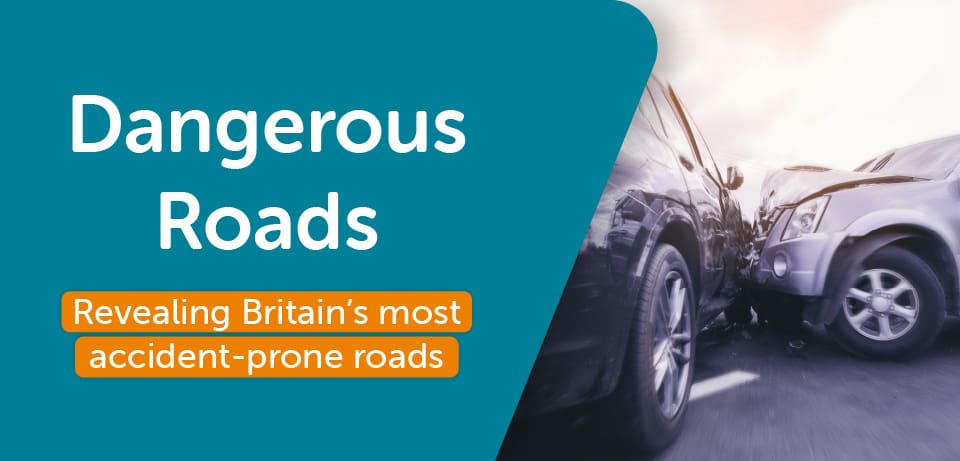
Revealing Britain’s most accident-prone roads.
Whether you’ve got a car on finance or own one outright, being in an accident isn’t a pleasant experience. An accident can happen on any road, whether driving down the motorway or on a country lane, but you might wonder where most accidents occur.
Our research from 2019 showed that Kent, Surrey, and Birmingham have the most accidents. But is this still true in 2023?
Looking at accident data from the Department for Transport, we’ve found the areas with the most road accidents. We’ll also answer questions like whether you’re more likely to crash in an urban or rural area and look at the characteristics of roads that make an area more or less dangerous.
We’ll also reveal the speeds at which most accidents occur and the junction types that see the most.
The top 3 areas with the most accidents
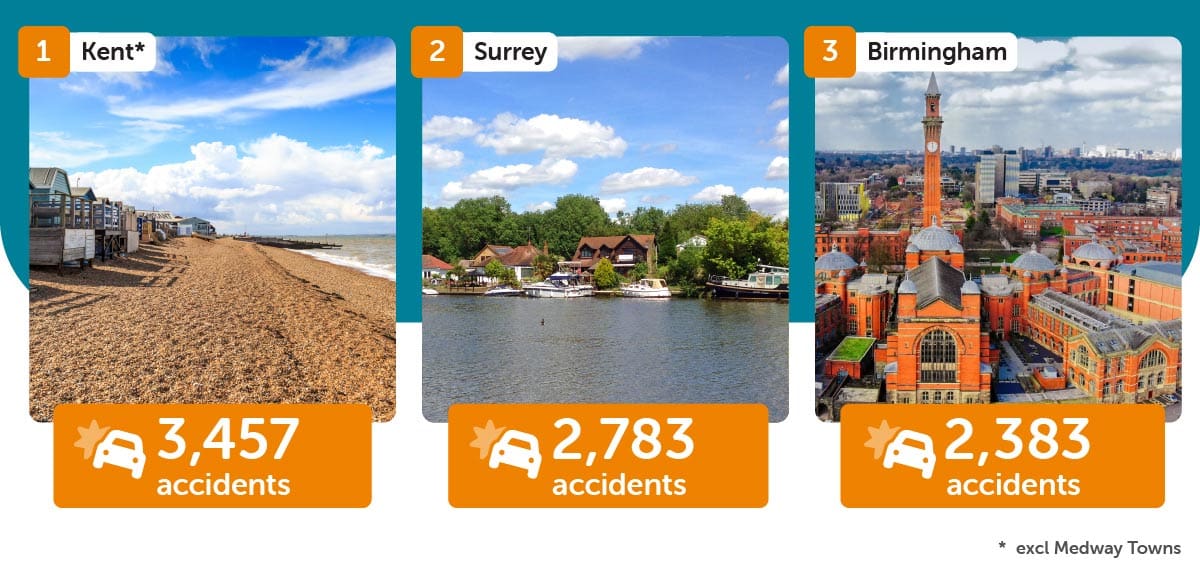
- Kent (excluding Medway towns): 3,457 accidents
The southeastern county of Kent had the most accidents in 2023 by some distance, with 3,457 in total.
While this figure excludes the Medway towns such as Gillingham and Rochester, Kent is still one of the most heavily populated counties in the country, with lots of traffic heading not just to the towns mentioned but also into London.
- Surrey: 2,783 accidents
Another of the home counties had the second-highest number of accidents, this time Surrey, with 2,783 taking place in 2023.
Like Kent, Surrey is a fairly well-populated county with large rural areas and many commuters, which could contribute to the high number of accidents.
- Birmingham: 2,383 accidents
The urban area with the highest number of accidents is Birmingham, the UK’s second-most-populated city with over 1.1 million people. With so many people on the move, there were 2,383 reported accidents in Birmingham in 2023.
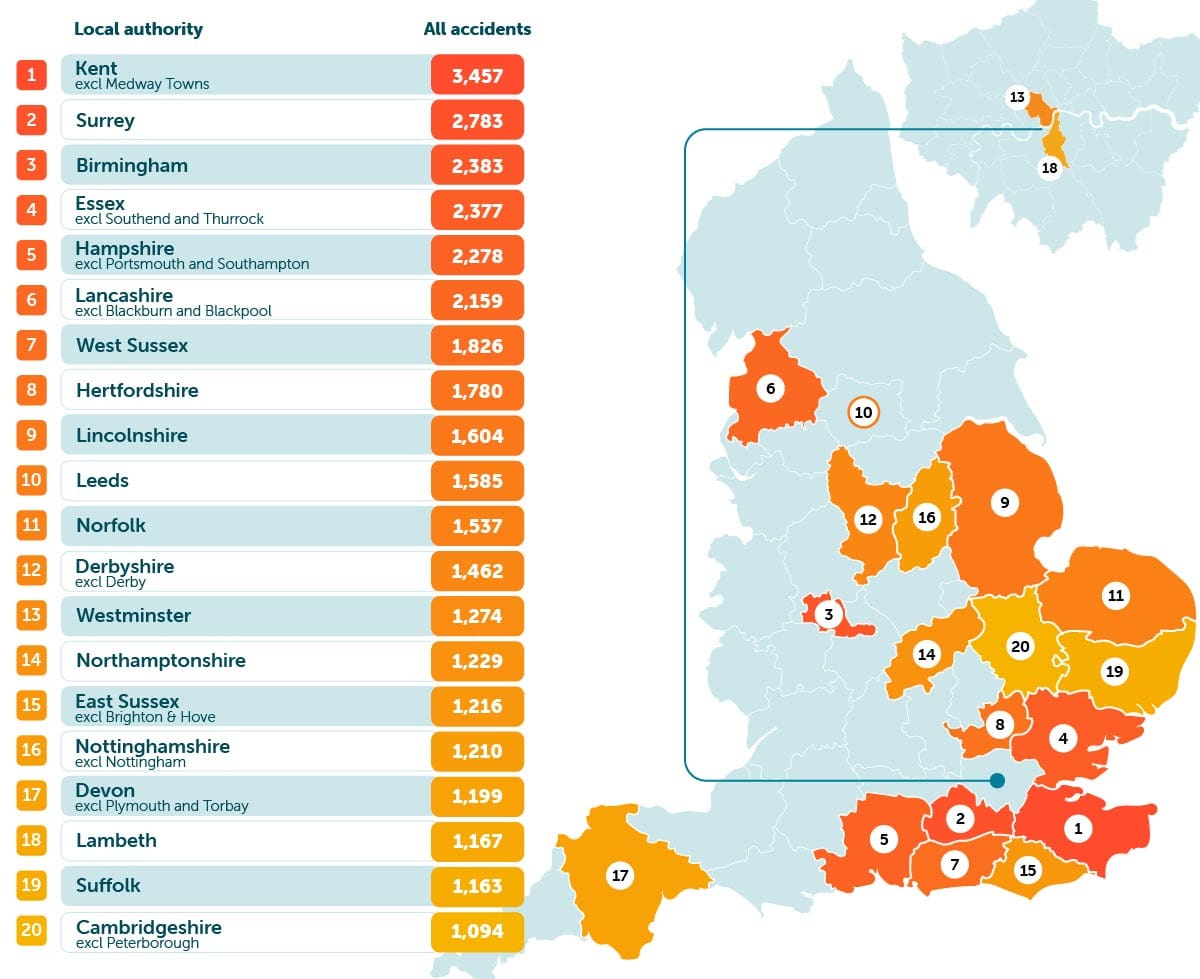
The areas where accidents have decreased over time
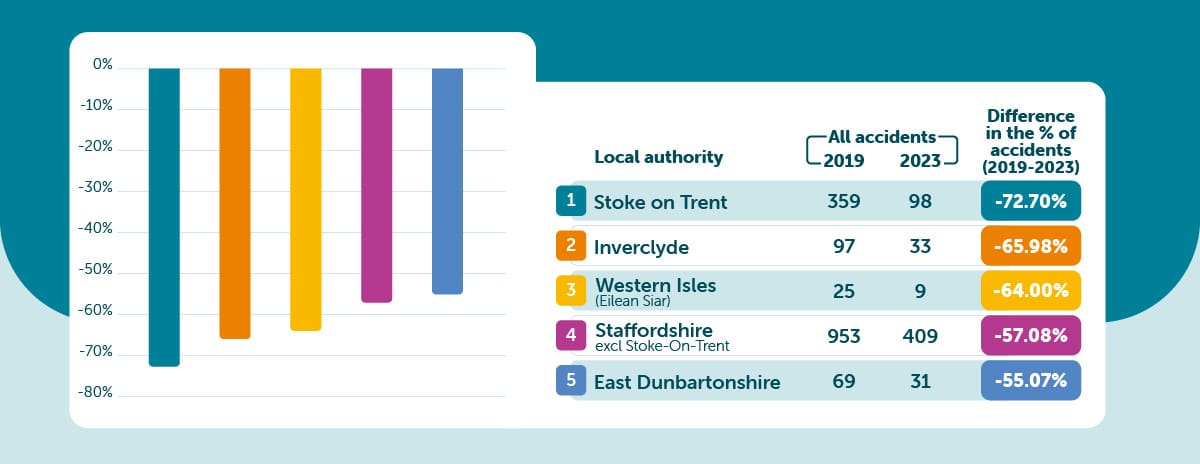
Stoke on Trent recorded a whopping 72.70% decrease in accidents since 2019, followed by Inverclyde in Scotland, with a decline of 65.98%, and the Western Isles of Scotland, where accidents were down by 64%.
The areas where accidents have increased over time
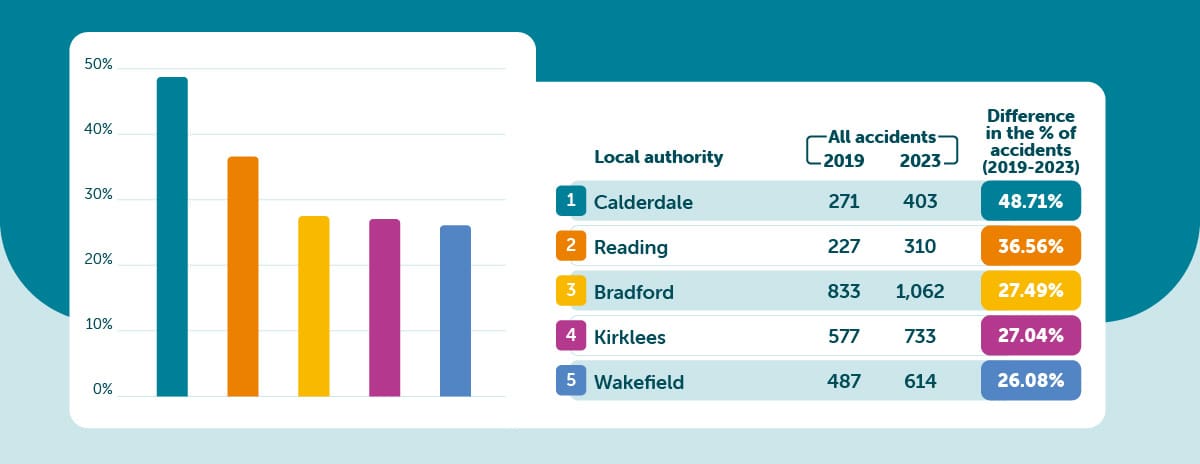
Calderdale, a metropolitan borough in West Yorkshire, recorded the highest increase in accidents since 2019, by 48.71%. Reading was second, with 227 accidents in 2019 and 310 in 2023, which is a 36.56% increase. Bradford came third, recording 1,062 accidents in 2023 and 833 in 2019, an increase of 27.49%.
What types of roads do accidents take place on?
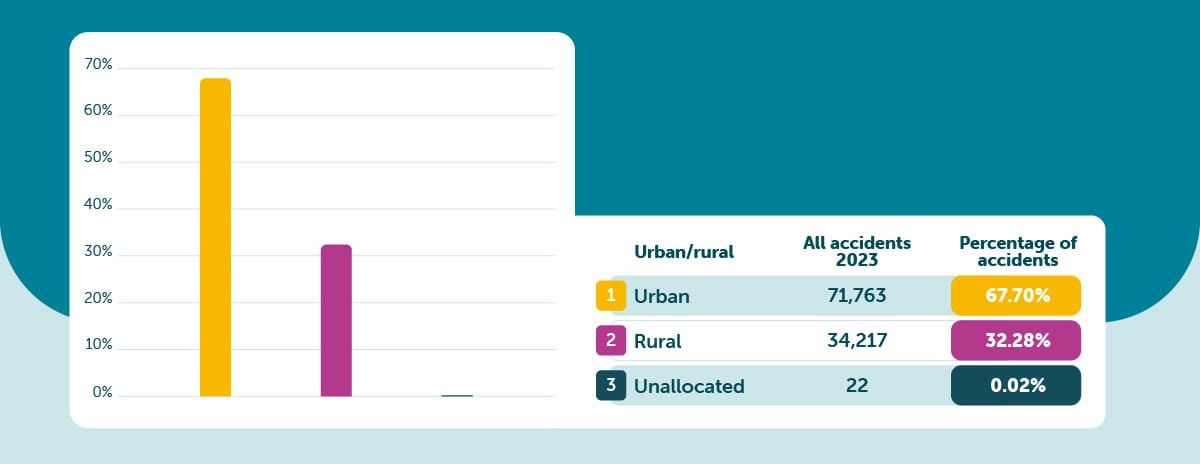
So, while we know the specific parts of the country that see the most accidents, what characteristics of roads make these places more or less dangerous?
Firstly, we looked at whether you’re more likely to crash in an urban or rural area, showing that there are twice as many accidents in built-up areas than in the countryside.
While this makes sense, with there usually being more vehicles on the roads, it’s worth noting that those accidents that occur on rural roads are likely to be more serious, rather than just a small bump you might get in a town or city. According to road safety charity Brake, more than half of fatal crashes in Britain occur on rural roads.
The increase in urban road accidents since 2019
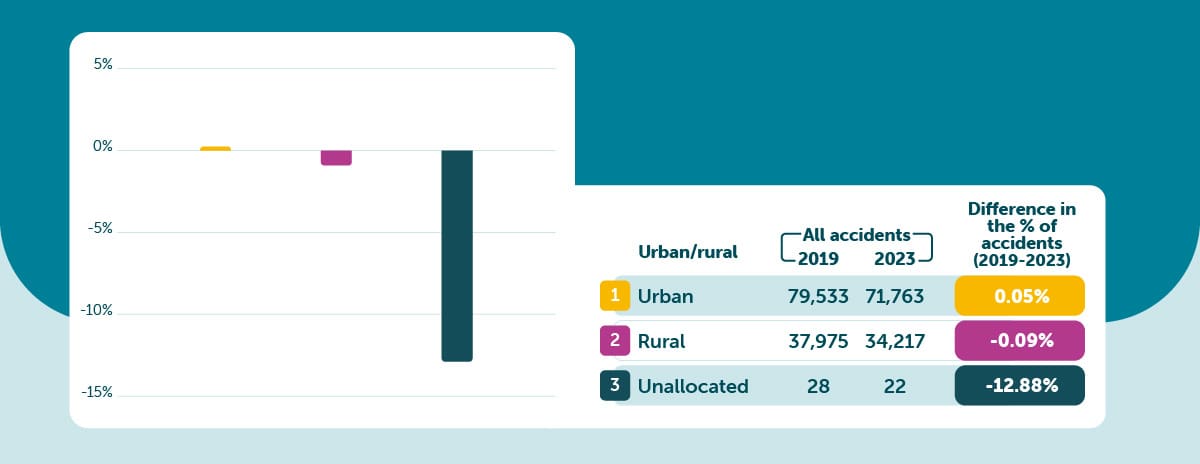
Urban roads were also most likely to be the cause of accidents in 2019, and there has been an increase of 0.05% in recorded accidents since then. However, there has also been a slight decline in accidents on rural roads (-0.09% decrease since 2019).
Looking at the specific classes of roads in the UK, we already know that motorways see a relatively low number of accidents given the pace of traffic flow, so which roads are accidents taking place on?
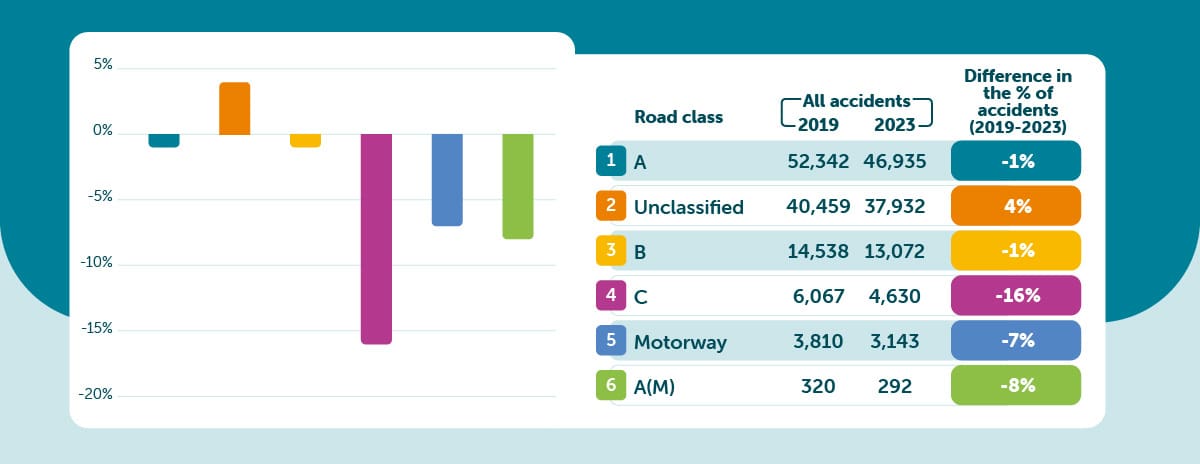
A roads were the road class with the most accidents in 2019, accounting for 44.50% of accidents. A roads have since seen a decrease of 1% in accidents, while unclassified roads have seen an increase in accidents by 4% since 2019.
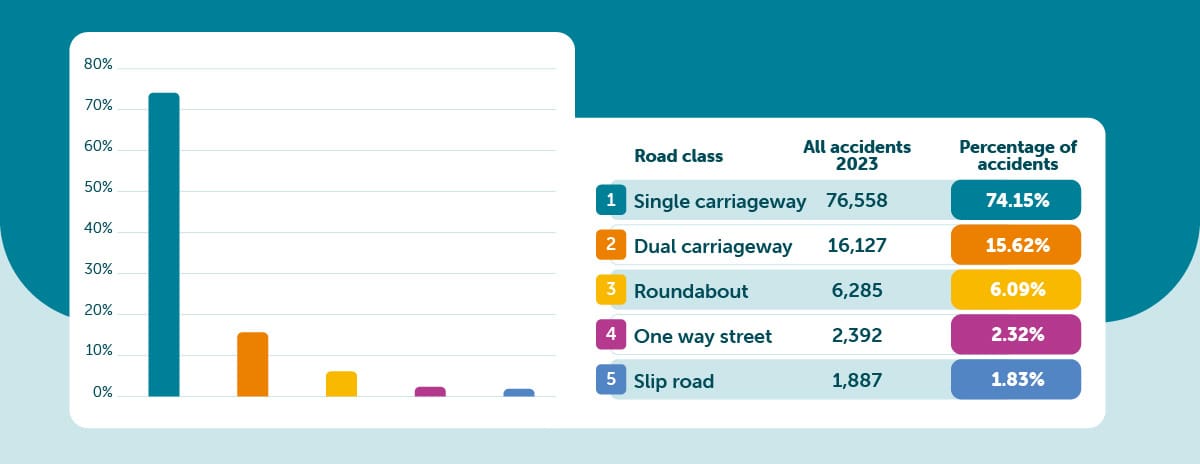
Nearly three-quarters of accidents occur on single-carriageway roads, which refers to roads with traffic following both directions and a maximum speed limit of 60 mph. In contrast, 15.21% of accidents occurred on dual carriageways, with a 70 mph limit, and as few as 5.93% were recorded on roundabouts.
The speeds at which most accidents happen
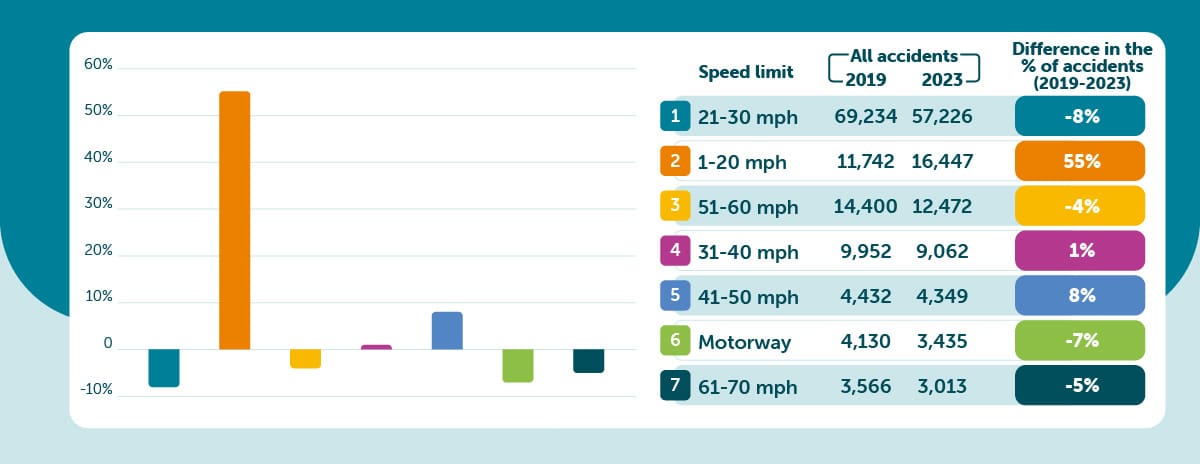
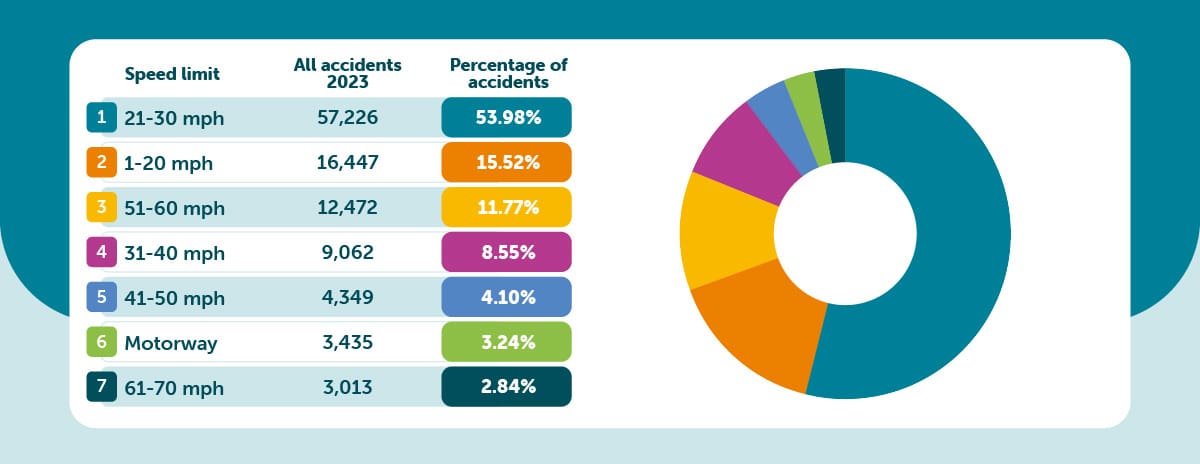
While you might think that roads with higher speed limits, such as motorways, would see the most accidents, the opposite is true. Our study reveals that most accidents (53.98%) occur within the 21-30 mph speed range. At the same time, roads with speed limits up to 70 mph had the fewest crashes (2.84%), showing that speed isn’t the only factor at play when collisions occur.
In 2019, speed limits between 21 and 30 mph were the most likely to cause accidents (58.9%), the same as in 2023. Roads with speed limits up to 60 mph were the second biggest cause of accidents in 2019 (12.3%). However, this has now changed according to our most recent data. Since 2019, accidents on roads with speed limits of up to 20 mph have increased by 55%.
The junction types with the most accidents
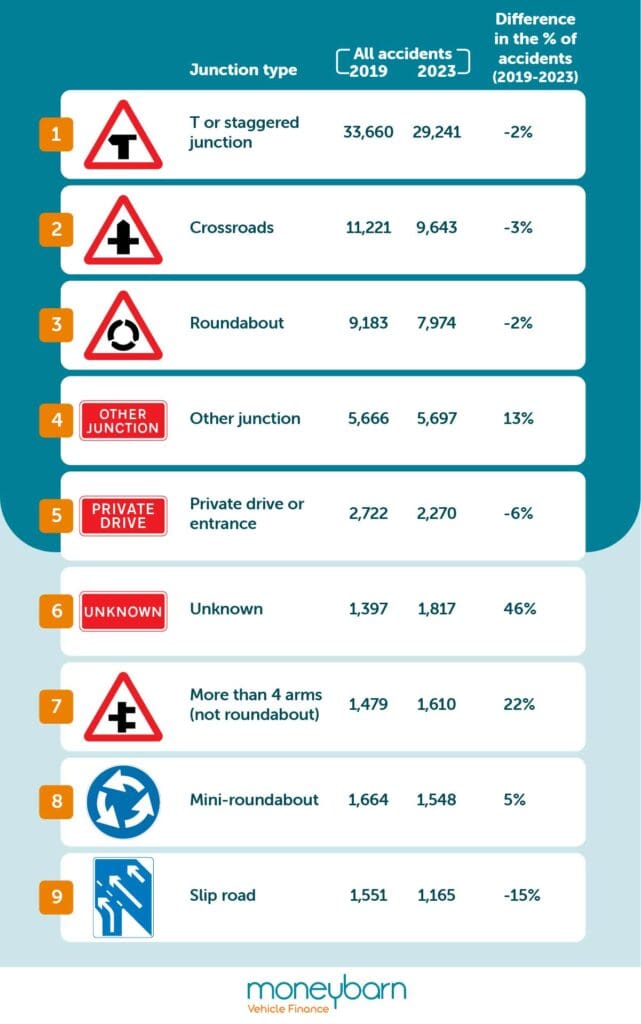
Almost half of accidents (41.56%) occur within 20 metres of junctions, but which type of junctions are the most dangerous? With around three times as many accidents as any other type of junction, the answer is the T or staggered junction, with over 29,200 accidents, making up about 28% of accidents.
These junctions see a minor road connect to a major road, with these roads being slightly offset in the case of the staggered junction.
This was followed by the standard crossroad junction (9.24%) and roundabouts (7.64%).
So, finally, how have accidents at junctions changed since 2019? Accidents on junctions with more than four arms have increased by 22% since 2019 and on mini-roundabouts by 5%. But, since 2019, there has been a decline in accidents on slip roads.
Methodology
The data used in our study is accurate as of September 2023.
You can view the data from our 2021 study here.
All figures are from the Department for Transport’s road traffic statistics road safety data download tool and refer to road accidents reported to the police in 2023 where at least one person is injured (there can be several casualties in one accident).
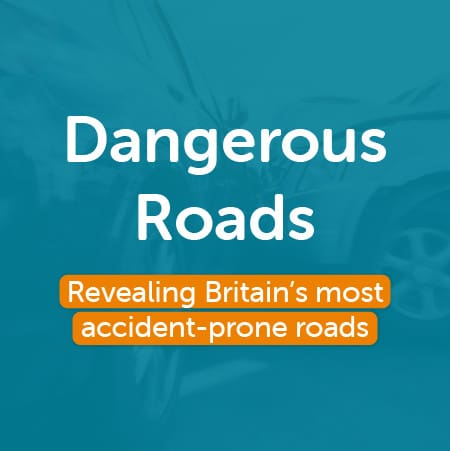
Revealing Britain’s most accident-prone roads.
Whether you’ve got a car on finance or own one outright, being in an accident isn’t a pleasant experience. An accident can happen on any road, whether driving down the motorway or on a country lane, but you might wonder where most accidents occur.
Our research from 2019 showed that Kent, Surrey, and Birmingham have the most accidents. But is this still true in 2023?
Looking at accident data from the Department for Transport, we’ve found the areas with the most road accidents. We’ll also answer questions like whether you’re more likely to crash in an urban or rural area and look at the characteristics of roads that make an area more or less dangerous.
We’ll also reveal the speeds at which most accidents occur and the junction types that see the most.
The top 3 areas with the most accidents
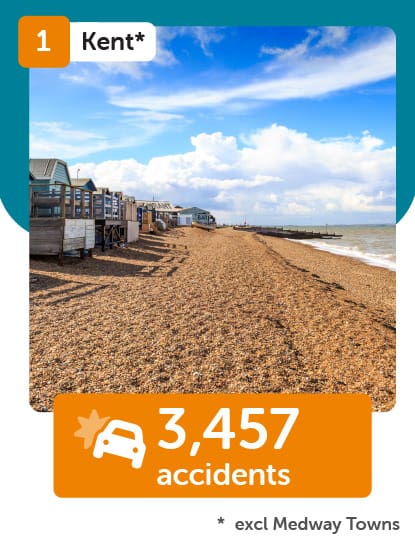
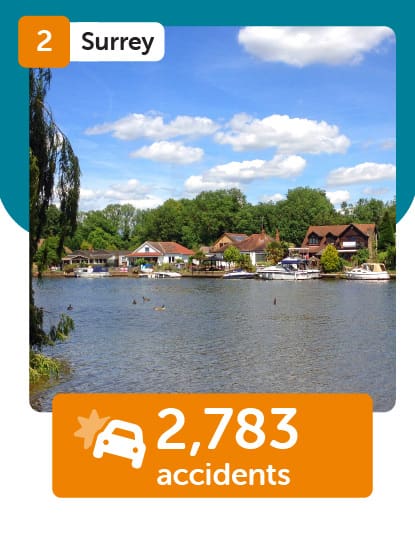
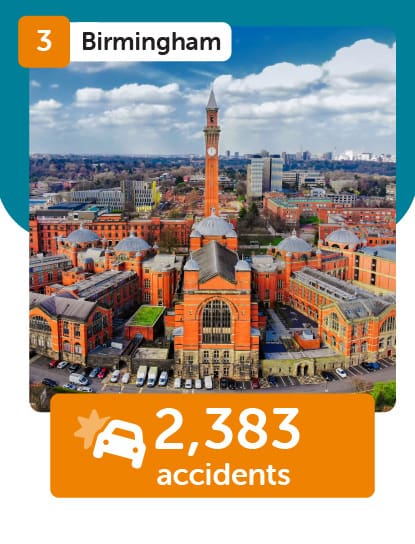
- Kent (excluding Medway towns): 3,457 accidents
The southeastern county of Kent had the most accidents in 2023 by some distance, with 3,457 in total.
While this figure excludes the Medway towns such as Gillingham and Rochester, Kent is still one of the most heavily populated counties in the country, with lots of traffic heading not just to the towns mentioned but also into London.
- Surrey: 2,783 accidents
Another of the home counties had the second-highest number of accidents, this time Surrey, with 2,783 taking place in 2023.
Like Kent, Surrey is a fairly well-populated county with large rural areas and many commuters, which could contribute to the high number of accidents.
- Birmingham: 2,383 accidents
The urban area with the highest number of accidents is Birmingham, the UK’s second-most-populated city with over 1.1 million people. With so many people on the move, there were 2,383 reported accidents in Birmingham in 2023.
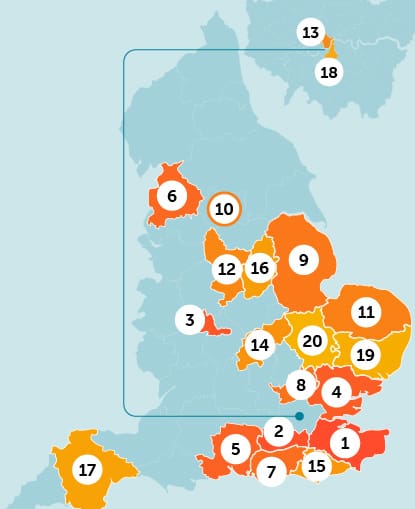
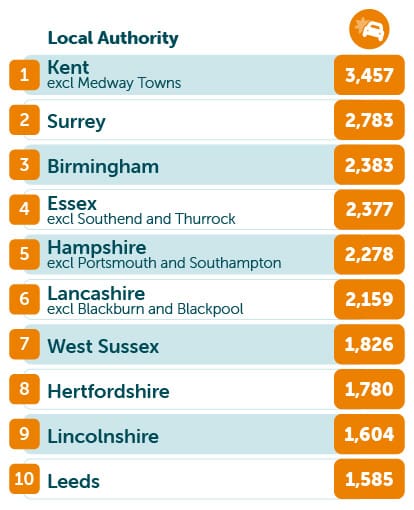
The areas where accidents have decreased over time
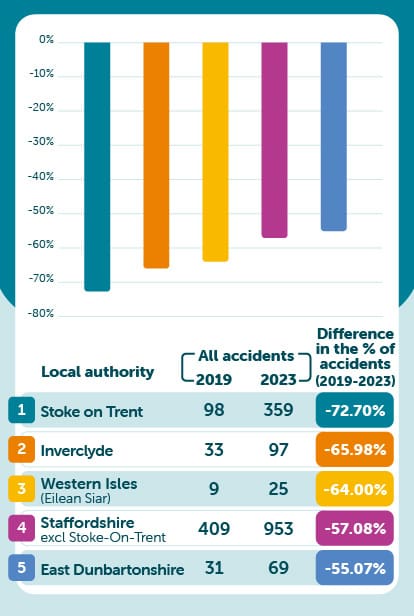
Stoke on Trent recorded a whopping 72.70% decrease in accidents since 2019, followed by Inverclyde in Scotland, with a decline of 65.98%, and the Western Isles of Scotland, where accidents were down by 64%.
The areas where accidents have increased over time
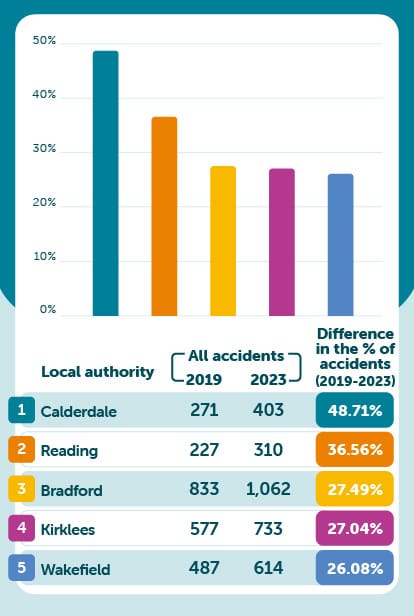
Calderdale, a metropolitan borough in West Yorkshire, recorded the highest increase in accidents since 2019, by 48.71%. Reading was second, with 227 accidents in 2019 and 310 in 2023, which is a 36.56% increase. Bradford came third, recording 1,062 accidents in 2023 and 833 in 2019, an increase of 27.49%.
What types of roads do accidents take place on?
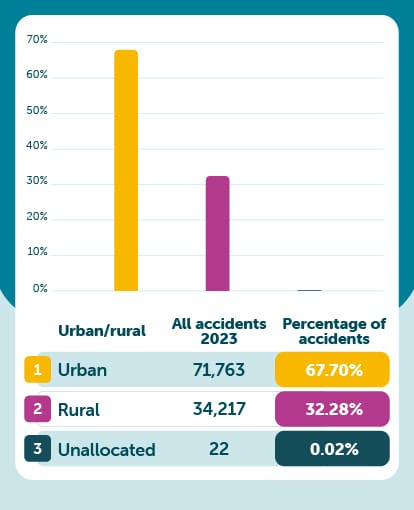
So, while we know the specific parts of the country that see the most accidents, what characteristics of roads make these places more or less dangerous?
Firstly, we looked at whether you’re more likely to crash in an urban or rural area, showing that there are twice as many accidents in built-up areas than in the countryside.
While this makes sense, with there usually being more vehicles on the roads, it’s worth noting that those accidents that occur on rural roads are likely to be more serious, rather than just a small bump you might get in a town or city. According to road safety charity Brake, more than half of fatal crashes in Britain occur on rural roads.
The increase in urban road accidents since 2019
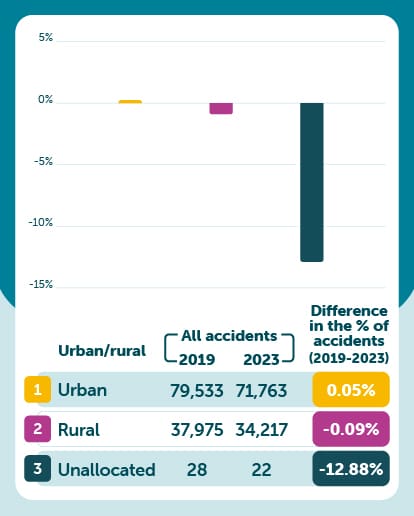
Urban roads were also most likely to be the cause of accidents in 2019, and there has been an increase of 0.05% in recorded accidents since then. However, there has also been a slight decline in accidents on rural roads (-0.09% decrease since 2019).
Looking at the specific classes of roads in the UK, we already know that motorways see a relatively low number of accidents given the pace of traffic flow, so which roads are accidents taking place on?
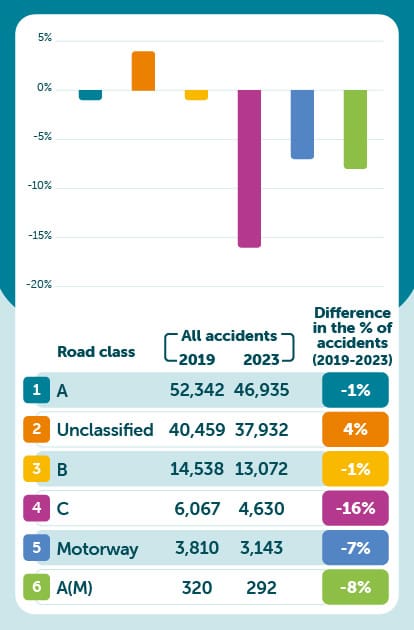
A roads were the road class with the most accidents in 2019, accounting for 44.50% of accidents. A roads have since seen a decrease of 1% in accidents, while unclassified roads have seen an increase in accidents by 4% since 2019.
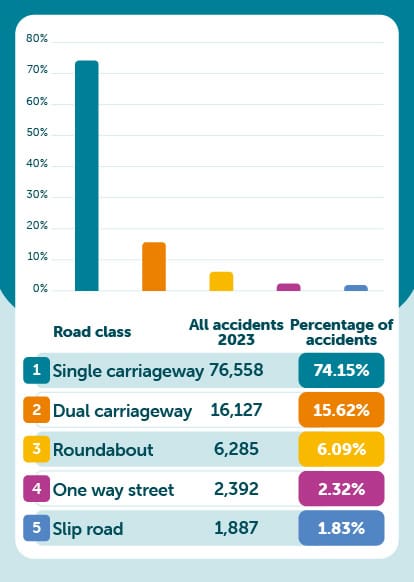
Nearly three-quarters of accidents occur on single-carriageway roads, which refers to roads with traffic following both directions and a maximum speed limit of 60 mph. In contrast, 15.21% of accidents occurred on dual carriageways, with a 70 mph limit, and as few as 5.93% were recorded on roundabouts.
The speeds at which most accidents happen
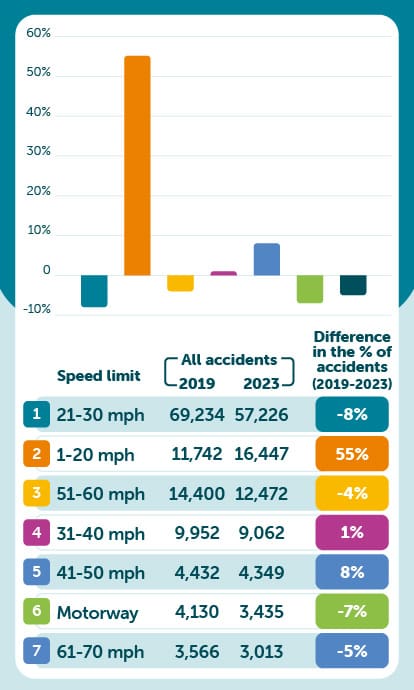
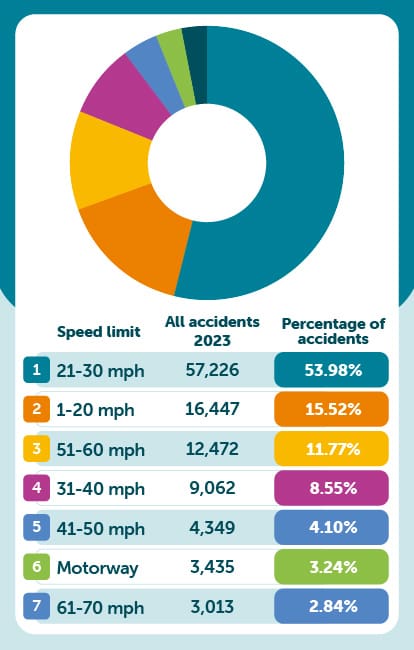
While you might think that roads with higher speed limits, such as motorways, would see the most accidents, the opposite is true. Our study reveals that most accidents (53.98%) occur within the 21-30 mph speed range. At the same time, roads with speed limits up to 70 mph had the fewest crashes (2.84%), showing that speed isn’t the only factor at play when collisions occur.
In 2019, speed limits between 21 and 30 mph were the most likely to cause accidents (58.9%), the same as in 2023. Roads with speed limits up to 60 mph were the second biggest cause of accidents in 2019 (12.3%). However, this has now changed according to our most recent data. Since 2019, accidents on roads with speed limits of up to 20 mph have increased by 55%.
The junction types with the most accidents
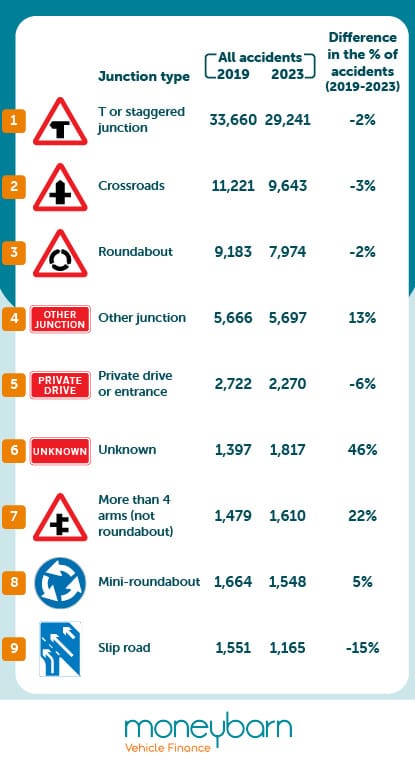
Almost half of accidents (41.56%) occur within 20 metres of junctions, but which type of junctions are the most dangerous? With around three times as many accidents as any other type of junction, the answer is the T or staggered junction, with over 29,200 accidents, making up about 28% of accidents.
These junctions see a minor road connect to a major road, with these roads being slightly offset in the case of the staggered junction.
This was followed by the standard crossroad junction (9.24%) and roundabouts (7.64%).
So, finally, how have accidents at junctions changed since 2019? Accidents on junctions with more than four arms have increased by 22% since 2019 and on mini-roundabouts by 5%. But, since 2019, there has been a decline in accidents on slip roads.
Methodology
The data used in our study is accurate as of September 2023.
You can view the data from our 2021 study here.
All figures are from the Department for Transport’s road traffic statistics road safety data download tool and refer to road accidents reported to the police in 2023 where at least one person is injured (there can be several casualties in one accident).
Bringing you the latest news and insights from Moneybarn.
More from Moneybarn...
For a better road ahead
Moneybarn is a member of the Finance and Leasing Association, the official trade organisation of the motor finance industry. The FLA promotes best practice in the motor finance industry for lending and leasing to consumers and businesses.
Moneybarn is the trading style of Moneybarn No. 1 Limited, a company registered in England and Wales with company number 04496573. The registered address is Athena House, Bedford Road, Petersfield, Hampshire, GU32 3LJ.
Moneybarn’s VAT registration number is 180 5559 52.
Moneybarn No. 1 Limited is authorised and regulated by the Financial Conduct Authority (Financial Services reference No. 702780)




